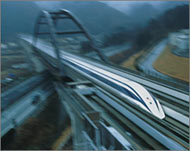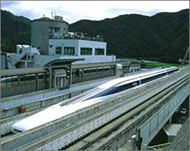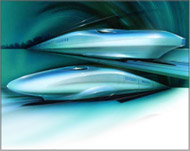Japan sets eyes on speedier trains
The race to develop the mass transport technology of the future is on.

For 40 years, Japan’s bullet train expertise has been the envy of other nations’ high-speed transport systems, but now what has become for many the symbol of the country – a train speeding past a snow-capped Mount Fuji – has a rival.
The bullet train is close to being overtaken.
Central Japan Railways Co has been working on a magnetically levitated train that in trials has repeatedly smashed its own speed records and is close to hitting 600km an hour.
New technology
“It is very important for Japan to develop this Maglev technology for several reasons, the most pressing of which is the need to link the major cities of Tokyo, Nagoya and Osaka,” says Yoshitsugu Hayashi, a professor of railway technology at Nagoya University.
 |
|
The new train would travel at |
“Japan has to compete economically with other nations in Asia, especially China, and linking these three cities into one easily accessible metropolis will help us do that.
“The three cities have different economic strengths and the two-and-a-half hours it takes now to get to Osaka, for people and freight, is just too long for Japan to be able to sustain its economy in the face of competition,” he said.
In addition, it is important that Japan continues to lead a field that will have numerous practical applications in the future in a world in which traditional fuel sources have been exhausted, he said.
Different views
But while JR Central believes that its Maglev technology is the most appropriate approach to the problem, not every one thinks so.
Rival East Japan Railway Co is of the opinion a new generation of the tried-and-trusted bullet train is the answer to the problem of transporting increasing numbers of people and volumes of freight over shorter distances at speeds that are comparable to those of commercial aircraft.
And while the two companies are coy in their comments on their rival’s system, the seven firms that were formed after Japan National Railway was split into six private passenger carriers and a freight carrier nearly 17 years ago, have kept a close eye on each others’ operations since then.
JR Central officials are clearly proud of the huge technological strides the Maglev has achieved.
The revolutionary vehicle has no wheels, but runs levitated above a guideway. It is propelled by a repulsive force and an attractive force between powerful magnets aboard the train and alongside the track.
Continuing research
Research to date has cost a total of Y166 billion ($1.6 billion), much of which has come from the government since it was designated as a national project.
 |
|
Stretched nose cones will reduce |
“I went aboard a test vehicle for a run and it was more like being in an aeroplane than a train,” says Kuniko Habu, a spokeswoman for JR Central. “We went at 500km per hour and although there was no wheel sound, like there is on a normal train, there was still some noise from the wind outside.”
And while magnetically levitated technology is being studied elsewhere, including Germany and the United States, there are major differences in the perceived applications.
Truncated Maglev tracks at Birmingham International Airport, in central England, and Shanghai’s airport were abandoned when it became apparent that over short distances they offered no comparative advantage over existing transportation systems – except the novelty value.
JR Central is not interested in slowly ferrying commuters to work; it is planning to take thousands of passengers and tons of freight over long distances and at speeds that were unthinkable just a few years ago.
New record
In December, a manned Maglev broke its own rail speed record by hitting 581km an hour on the 18.4km test track in Yamanashi, at the base of Mount Fuji, west of Tokyo.
Travelling at that speed, the journey time between the capital and Osaka would be reduced to one hour, less than half the time it takes for the present generation of bullet trains to complete the journey.
“There is a strong degree of rivalry in these two firms’ projects,” says Makoto Arisawa, a professor of transportation systems at Tokyo’s Keio University, although he has reservations about the Maglev project.
“JR Central is pursuing the hardest way as it has to tackle environmental and health problems, in addition to the high-speed train technology,” he says.
Makoto believes JR East’s plan to improve on existing bullet train know-how will proceed more smoothly, even though the demand for faster ground links is more pressing in central Japan, particularly in the Tokyo-Osaka corridor.
Nagging concerns
“I have not believed in the Maglev since the start,” he says. “I worry about health problems associated with the technology as well as environmental hazards.
“We must note that Maglev experiments have been under way for more than 20 years and they are still doing the research work,” he says.
 |
|
Research bill so far: $1.6 billion |
But JR Central dismisses the suggestion that the technology is in any way dangerous.
“We have followed the World Health Organisation’s report that says an electromagnetic force of less than 50 gals has no effect on the human body.
And at the Maglev test line, in Yamanashi Prefecture, we have experimented with a wall outside the car that shields passengers inside the car from the waves,” says Habu, adding that measurements within the car put the level of gals at just 20.
Innovative rivalry
Not wanting to be left behind, JR East on 11 February announced plans to build two new bullet trains with a maximum speed of 400km an hour that could be in operation by 2013 and link Tokyo and Aomori, on the northern tip of the main Japanese island of Honshu, in three hours.
Company President Mutsutake Otsuka emphasised to a news conference that the vehicles would be the fastest conventional commercial trains in the world.
The company is spending about $144.5 million a year on the project with 117 engineers working on the technology at its research and development centre, according to a spokesman for the company.
New motors that are lighter and more compact than anything presently in service will power the prototypes.
Moreover, the stretched nose cones will be about 16m long and designed to reduce the shock when the train enters a tunnel.
Shortcomings
“Both systems have drawbacks,” believes professor Hayashi. “JR East is limited in its maximum speed to around 400km per hour due to wheel vibration and noise where it comes into contact with a conventional track, while the Maglev suffers from wind impact sound.”
|
Central Japan Railways Co has been working on a magnetically levitated train that in trials has repeatedly smashed its own speed records and is close to hitting 600km per hour. |
One reason the two firms have chosen different routes, Hayashi says, is JR East’s desire to keep the new bullet train compatible with its existing fleet of vehicles, while JR Central plans to build a dedicated Maglev track between Tokyo and Osaka to supplement its bullet train routes.
But there is another reason, he suggests.
“I get the impression that the corporate mentality and the characteristics of the heads of the two companies are very different,” he says. “JR Central is more challenging while JR East is more conservative and takes fewer risks.”
The Japanese government has been promoting bullet trains in a number of countries that have been considering the introduction of high-speed railway links, notably China, which wants a connection between Beijing and Shanghai.
And it is likely that Maglev technology will be similarly endorsed as soon as it is perfected – although JR Central refuses to be drawn on when that might be.
Affecting flights
But perhaps the biggest impact will be on domestic flights, according to Nagoya University’s professor Hayashi.
“I think this will hit airline firms operating on medium-range domestic routes very hard,” he says.
“We’ve already seen it in the past; when the Tokaido bullet train was first introduced 40 years ago, the Ministry of Transport stopped flights between Tokyo’s Haneda airport and Nagoya. The same will happen again between Tokyo and Osaka.
“But,” he admits, “we are a few years away from that scenario yet.”